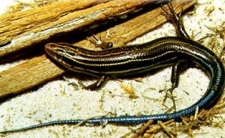Wildlife - Species

Southeastern Five-lined Skink (Eumeces inexpectatus)
Description
Southeastern five-lined skinks belong to the family Scincidae, one of the two largest families of lizards. As their name suggests, southeastern five-lined skinks have five characteristic narrow stripes along their bodies that become lighter with age. The middle stripe tends to be narrower than the others, and the dark areas between stripes are black in young skinks but become brown with age. A similar species, the five-lined skink (Eumeces fasciatus), is smaller than the southeastern five-lined skink and has broader stripes. However, it is difficult to discriminate between these two species on the basis of physical appearance. Young southeastern five-lined skinks have a bright blue or purplish tail, especially towards the tip. Also, stripes become a bright reddish orange towards the head. Juvenile coloration may persist into adulthood, giving the head of the animal an altogether orange-brown appearance.
Preferred Habitat and Biology
Southeastern five-lined skinks are common inhabitants of wooded areas of the southeastern United States They are commonly found in small islands off the southeastern coast even in the absence of fresh water and vegetation.
Most species of skinks are small and are active during the day. Similar to other lizard species, skinks exhibit autotomy; that is, they purposely break their tails when confronted with danger. This break occurs at specialized vertebrae that are split by contractions of the surrounding muscles. Excessive bleeding is prevented by sphincter muscles in the tail stump that constrict the caudal artery. It is thought that the purpose of this behavior is to confuse predators. The wriggling tail draws the predator’s attention away from the lizard, which makes a quick escape. The lost tail is then slowly regenerated. However, the new tail differs from the original in that it has a cartilaginous rod for support instead of vertebrae, its scales are of different size and shape, and its musculature and color are different. Southeastern five-lined skinks feed mainly on insects, preferring larger prey items such as grasshoppers. They are oviparous, and clutch size is 6 to 12 eggs, depending on the size of the female. There is indication of a latitudinal trend, with diminishing clutch sizes at higher latitudes. Female skinks brood their eggs and protect them from predators, including other skinks. Eggs are laid during the summer, and hatchlings emerge one month after being laid.
References
Conant, R. 1975. A field guide to reptiles and amphibians of eastern and central North America. Houghton Mifflin Company, Boston, MA.
Martof, B. S., Palmer, W. M., Bailey, J. R., Harrison III, J. R. 1980. Amphibians and reptiles of the Carolinas and Virginia. The University of North Carolina Press, Chapel Hill.
Smith, H. 1946. Handbook of Lizards. Cornell University Press, Ithaca, New York.
